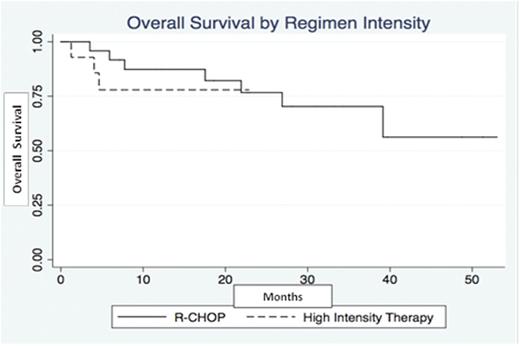Abstract
Background: High grade B cell lymphoma (HGBL) is a heterogeneous entity with morphologic and genetic features intermediate between diffuse large B-cell lymphoma and Burkitt lymphoma (BL). Many patients with HGBL also have concurrent MYC, BCL2 and/or BCL6 rearrangements documented by FISH, the so-called double-hit lymphoma (DHL), which has now been defined as a separate entity in the updated WHO classification in 2016 as HGBL with rearrangements of MYC and BCL2 and/or BCL6. Other HGBL without MYC and BCL2 or BCL6 have been termed HGBL, NOS. HGBL, NOS and DHL are considered clinically aggressive. The best therapeutic approach for HGBL, NOS is unclear, and outcomes of patients with DHL in comparison to HGBL, NOS are not well established.
Objective: The aim of this study was to evaluate and describe the outcomes and practice patterns for patients with HGBL, NOS. Additionally, we compared the survival of patients with HGBL, NOS to those with DHL.
Materials and Methods: This retrospective cohort study was conducted at the University of Pittsburgh Medical Center. All patients identified as HGBL by pathology review at the University of Pittsburgh Hematopathology Department from 2010-2014 were included. Outcomes between standard therapy with R-CHOP and high intensity therapies with either R-EPOCH or R-HyperCVAD were compared for those patients with HGBL. Survival curves were generated with the Kaplan-Meier method, and overall survival was compared using the log-rank test. Cox-regression analysis was used to adjust for covariates.
Results: 50 patients with newly diagnosed HGBL without a double-hit genotype were identified. Of these patients, 38 received R-CHOP (63%), R-EPOCH (21%) or R-HyperCVAD (16%). Baseline characteristics between treatment groups (Table 1) revealed an older age (p=0.033) and more frequent germinal center genotype (p=0.023) in those treated with R-CHOP. Median follow-up for this group was 18 months. There was no difference in the overall survival (OS) between R-CHOP and higher intensity regimens (p=0.540) (Figure 1). Median survival was not reached in either group. 2-year survival was 76%. Only a high-risk IPI score retained prognostic significance with OS in multivariate analysis (p=0.022). This compares favorable to 13 cases of DHL treated with R-CHOP, R-EPOCH, or R-HyperCVAD during a similar time period for whom the median overall survival was 8.9 months (p=0.016)
Conclusion: Both standard therapy with R-CHOP and higher intensity therapies appear to be effective in the treatment of HGBL without double-hit genotype. IPI score remains prognostically significant. Outcomes in patients with HGBL, NOS appear favorable in comparison with patients with DHL.
No relevant conflicts of interest to declare.
Author notes
Asterisk with author names denotes non-ASH members.



This feature is available to Subscribers Only
Sign In or Create an Account Close Modal